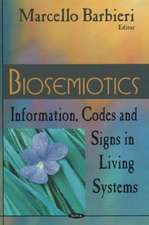Numerical Methods for the Life Scientist: Binding and Enzyme Kinetics Calculated with GNU Octave and MATLAB
Autor Heino Prinzen Limba Engleză Hardback – 5 aug 2011
| Toate formatele și edițiile | Preț | Express |
|---|---|---|
| Paperback (1) | 938.04 lei 6-8 săpt. | |
| Springer Berlin, Heidelberg – 22 aug 2016 | 938.04 lei 6-8 săpt. | |
| Hardback (1) | 941.82 lei 6-8 săpt. | |
| Springer Berlin, Heidelberg – 5 aug 2011 | 941.82 lei 6-8 săpt. |
Preț: 941.82 lei
Preț vechi: 1148.56 lei
-18% Nou
Puncte Express: 1413
Preț estimativ în valută:
180.24€ • 187.48$ • 148.80£
180.24€ • 187.48$ • 148.80£
Carte tipărită la comandă
Livrare economică 15-29 aprilie
Preluare comenzi: 021 569.72.76
Specificații
ISBN-13: 9783642208195
ISBN-10: 3642208193
Pagini: 154
Ilustrații: IX, 149 p.
Dimensiuni: 155 x 235 x 15 mm
Greutate: 0.34 kg
Ediția:2011
Editura: Springer Berlin, Heidelberg
Colecția Springer
Locul publicării:Berlin, Heidelberg, Germany
ISBN-10: 3642208193
Pagini: 154
Ilustrații: IX, 149 p.
Dimensiuni: 155 x 235 x 15 mm
Greutate: 0.34 kg
Ediția:2011
Editura: Springer Berlin, Heidelberg
Colecția Springer
Locul publicării:Berlin, Heidelberg, Germany
Public țintă
ResearchCuprins
Introduction
Classical enzyme kinetics
Classical dose-response curves and the Hill coefficient
Classical association and dissociation kinetics and exponential fits
Numerical methods
Preparing the computer
Installation of Octave for different platforms
Installation of Linux
Running the provided programs
Data input and output
Binding equilibria
Analytical and numerical solution for equilibrium binding to one site
Equilibrium binding to two or more sites.
Equilibrium binding to two or more conformational states
Equilibrium binding for oxygen to hemoglobin (MWC model)
Equilibrium binding of more than one ligand (e.g. agonist and inhibitor)
Enzyme kinetics as coupled equilibria
Enzyme kinetics with competitive or noncompetitive inhibitors
Dose-response curves for receptor agonists and enzyme inhibitors
Binding kinetics
Ligand binding kinetics of first and second order
Numerical solutions of differential equations
Calculation of true enzyme kinetics
Dissociation by dilution and dissociation by competition (“chase”)
States and sites
Least squares fit to experimental data
The function lsqcurvefit
Comparing correct binding curves with Hill equations
Comparing real binding kinetics with current multi-exponential fits
Fitting experimental data
Causes for errors
Multi-parameter fits
Correlation of parameters
Selecting a model and minimizing the number of parameters
Degrees of freedom
Global Fits
Significance of parameters in multi-parameter fits
Comparing the two different approaches
Model independent versus model calculations
Global fit versus single fits
Make ends meet: Try to analyze reported data with new methods
Designing experiments for complete analysis
Appendix
Description of program files
Sample data
Comparing MATLAB and Octave code
Classical enzyme kinetics
Classical dose-response curves and the Hill coefficient
Classical association and dissociation kinetics and exponential fits
Numerical methods
Preparing the computer
Installation of Octave for different platforms
Installation of Linux
Running the provided programs
Data input and output
Binding equilibria
Analytical and numerical solution for equilibrium binding to one site
Equilibrium binding to two or more sites.
Equilibrium binding to two or more conformational states
Equilibrium binding for oxygen to hemoglobin (MWC model)
Equilibrium binding of more than one ligand (e.g. agonist and inhibitor)
Enzyme kinetics as coupled equilibria
Enzyme kinetics with competitive or noncompetitive inhibitors
Dose-response curves for receptor agonists and enzyme inhibitors
Binding kinetics
Ligand binding kinetics of first and second order
Numerical solutions of differential equations
Calculation of true enzyme kinetics
Dissociation by dilution and dissociation by competition (“chase”)
States and sites
Least squares fit to experimental data
The function lsqcurvefit
Comparing correct binding curves with Hill equations
Comparing real binding kinetics with current multi-exponential fits
Fitting experimental data
Causes for errors
Multi-parameter fits
Correlation of parameters
Selecting a model and minimizing the number of parameters
Degrees of freedom
Global Fits
Significance of parameters in multi-parameter fits
Comparing the two different approaches
Model independent versus model calculations
Global fit versus single fits
Make ends meet: Try to analyze reported data with new methods
Designing experiments for complete analysis
Appendix
Description of program files
Sample data
Comparing MATLAB and Octave code
Textul de pe ultima copertă
Enzyme kinetics, binding kinetics and pharmacological dose-response curves are currently analyzed by a few standard methods. Some of these, like Michaelis-Menten enzyme kinetics, use plausible approximations, others, like Hill equations for dose-response curves, are outdated. Calculating realistic reaction schemes requires numerical mathematical routines which usually are not covered in the curricula of life science. This textbook will give a step-by-step introduction to numerical solutions of non-linear and differential equations. It will be accompanied with a set of programs to calculate any reaction scheme on any personal computer. Typical examples from analytical biochemistry and pharmacology can be used as versatile templates. When a reaction scheme is applied for data fitting, the resulting parameters may not be unique. Correlation of parameters will be discussed and simplification strategies will be offered.
Caracteristici
First advanced text for life scientists on numerical methods
Easy step-by-step introduction to numerical solutions
Installation guide for the free software GNU Octave
More than 30 programs (written in Octave) will provide templates for biochemical applications – available as supplementary electronic material
Analysis of experimental data by multi-parameter fits
Correlation of parameters, significance of the results
Includes supplementary material: sn.pub/extras
Easy step-by-step introduction to numerical solutions
Installation guide for the free software GNU Octave
More than 30 programs (written in Octave) will provide templates for biochemical applications – available as supplementary electronic material
Analysis of experimental data by multi-parameter fits
Correlation of parameters, significance of the results
Includes supplementary material: sn.pub/extras







